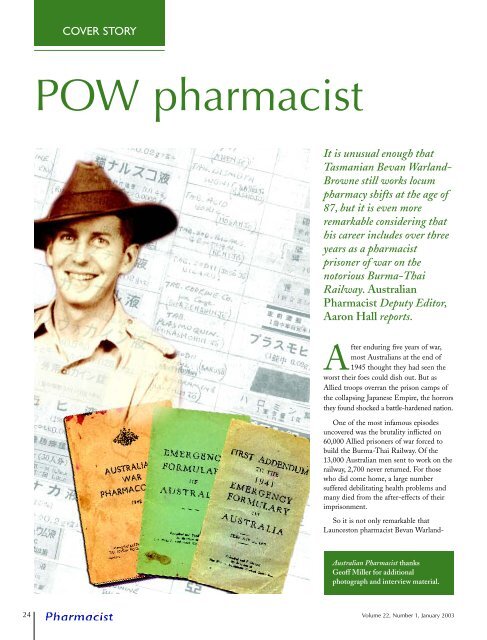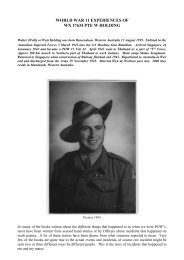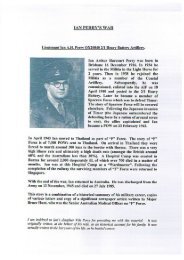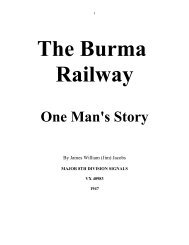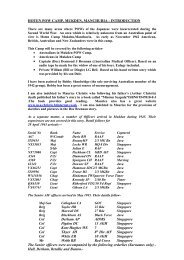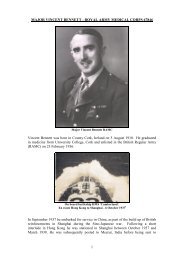Bevan Warland-Browne - Prisoners of War of the Japanese 1942-1945
Bevan Warland-Browne - Prisoners of War of the Japanese 1942-1945
Bevan Warland-Browne - Prisoners of War of the Japanese 1942-1945
Create successful ePaper yourself
Turn your PDF publications into a flip-book with our unique Google optimized e-Paper software.
COVER STORY<br />
POW pharmacist<br />
It is unusual enough that<br />
Tasmanian <strong>Bevan</strong> <strong><strong>War</strong>land</strong>-<br />
<strong>Browne</strong> still works locum<br />
pharmacy shifts at <strong>the</strong> age <strong>of</strong><br />
87, but it is even more<br />
remarkable considering that<br />
his career includes over three<br />
years as a pharmacist<br />
prisoner <strong>of</strong> war on <strong>the</strong><br />
notorious Burma-Thai<br />
Railway. Australian<br />
Pharmacist Deputy Editor,<br />
Aaron Hall reports.<br />
After enduring five years <strong>of</strong> war,<br />
most Australians at <strong>the</strong> end <strong>of</strong><br />
<strong>1945</strong> thought <strong>the</strong>y had seen <strong>the</strong><br />
worst <strong>the</strong>ir foes could dish out. But as<br />
Allied troops overran <strong>the</strong> prison camps <strong>of</strong><br />
<strong>the</strong> collapsing <strong>Japanese</strong> Empire, <strong>the</strong> horrors<br />
<strong>the</strong>y found shocked a battle-hardened nation.<br />
One <strong>of</strong> <strong>the</strong> most infamous episodes<br />
uncovered was <strong>the</strong> brutality inflicted on<br />
60,000 Allied prisoners <strong>of</strong> war forced to<br />
build <strong>the</strong> Burma-Thai Railway. Of <strong>the</strong><br />
13,000 Australian men sent to work on <strong>the</strong><br />
railway, 2,700 never returned. For those<br />
who did come home, a large number<br />
suffered debilitating health problems and<br />
many died from <strong>the</strong> after-effects <strong>of</strong> <strong>the</strong>ir<br />
imprisonment.<br />
So it is not only remarkable that<br />
Launceston pharmacist <strong>Bevan</strong> <strong><strong>War</strong>land</strong>-<br />
Australian Pharmacist thanks<br />
Ge<strong>of</strong>f Miller for additional<br />
photograph and interview material.<br />
24<br />
Volume 22, Number 1, January 2003
COVER STORY<br />
<strong>Browne</strong> survived <strong>the</strong> railway and regained<br />
his good health, but that he is still<br />
working regularly as a locum in nor<strong>the</strong>rn<br />
Tasmania.<br />
Now 87 years old, <strong>Bevan</strong> went to war<br />
as a staff-sergeant in <strong>the</strong> 2/4th Casualty<br />
Clearing Station (CCS), a medical unit<br />
formed from Tasmanian volunteers.<br />
His unit was captured amid <strong>the</strong> shambles<br />
<strong>of</strong> <strong>the</strong> Malayan collapse and <strong>the</strong>y were<br />
imprisoned in Changi before being sent to<br />
work on <strong>the</strong> railway.<br />
‘Australian doctors had<br />
never seen <strong>the</strong>se diseases–<br />
malaria <strong>of</strong> all types, pellagra,<br />
cholera, amoebic dysentry,<br />
bacillic dysentry, beri beri,<br />
blindness from vitamin<br />
deficiency ...’<br />
Just getting to <strong>the</strong> railway<br />
foreshadowed <strong>the</strong> horrors that were to<br />
follow as <strong>the</strong> <strong>Japanese</strong> packed <strong>the</strong><br />
prisoners onto one <strong>of</strong> <strong>the</strong>ir infamous<br />
‘hellships’ for transport to Moulmein in<br />
Burma (now known as Myanmar).<br />
Throughout <strong>the</strong> war <strong>the</strong> <strong>Japanese</strong><br />
routinely piled many hundreds <strong>of</strong> prisoners<br />
into <strong>the</strong> overcrowded holds <strong>of</strong> ships with<br />
minimal water, <strong>of</strong>ten no food, and no<br />
ventilation, for many days under <strong>the</strong><br />
tropical sun.<br />
Asked to describe conditions on <strong>the</strong><br />
railway, <strong>Bevan</strong> told Australian Pharmacist<br />
simply, ‘We were worked to death, starved<br />
to death ... and <strong>the</strong> diseases, well ...’<br />
The sentence trailed <strong>of</strong>f as he thought <strong>of</strong><br />
how to convey exactly what difficulties <strong>the</strong><br />
medical staff faced, particularly after <strong>the</strong><br />
malnourished prisoners had toiled for<br />
months cutting a railway by hand through<br />
dense jungle and mountainous terrain.<br />
‘Australian doctors had never seen <strong>the</strong>se<br />
diseases–malaria <strong>of</strong> all types, pellagra,<br />
cholera, amoebic dysentry, bacillic<br />
dysentry, beri beri, blindness from vitamin<br />
deficiency,’ <strong>Bevan</strong> said.<br />
He was sent to work for six months<br />
shovelling dirt on <strong>the</strong> railway, before being<br />
brought permanently into one <strong>of</strong> <strong>the</strong> many<br />
camps scattered along <strong>the</strong> 420km line to<br />
deal with <strong>the</strong> rapidly growing numbers <strong>of</strong><br />
sick prisoners. ‘I was “yaegio zaishu”–<br />
a pharmacist–and <strong>the</strong>y took me to a<br />
“hospital” ... just a few atap [bamboo and<br />
palm thatch] huts.’<br />
The POW doctors in <strong>the</strong>se hospitals<br />
along <strong>the</strong> railway have since become<br />
famous for <strong>the</strong>ir work, particularly<br />
Lieutenant Colonel Edward ‘Weary’<br />
Dunlop and Lieutenant Colonel Albert<br />
Coates, <strong>the</strong> doctor with whom <strong>Bevan</strong><br />
worked and who later gave evidence at <strong>the</strong><br />
post-war <strong>Japanese</strong> <strong>War</strong> Crimes Trials.<br />
For all camps along <strong>the</strong> railway, an<br />
acute shortage <strong>of</strong> drugs proved a constant<br />
problem to <strong>the</strong> medical staff.<br />
Australian journalist Rohan Rivett was<br />
in many <strong>of</strong> <strong>the</strong> same camps as <strong>Bevan</strong>–‘he<br />
kept his notes in my special wooden box<br />
with a false bottom and red cross’–and<br />
described <strong>the</strong> pitiful drugs situation in his<br />
book, Behind Bamboo: 1<br />
‘Quinine we had most <strong>of</strong> <strong>the</strong> time in<br />
reasonable quantity, which was not<br />
surprising since <strong>the</strong> Japs now controlled<br />
<strong>the</strong> world’s supply area. But every o<strong>the</strong>r<br />
hospital requirement was ei<strong>the</strong>r nonexistent<br />
or available only in hopelessly<br />
inadequate quantities. Hard work by<br />
orderlies–chiefly from <strong>the</strong> 2/4 CCS, a<br />
Tasmanian unit–and <strong>the</strong> camp<br />
“Buppin”, or works staff, resulted in<br />
<strong>the</strong> improvisation <strong>of</strong> a scanty but<br />
invaluable stock <strong>of</strong> tables,<br />
containers, pans and tins for<br />
boiling water. The <strong>Japanese</strong><br />
supplied a few antiseptics and<br />
a small quantity <strong>of</strong> things<br />
such as acriflavine,<br />
boracic and one or two<br />
healing agents, but<br />
<strong>the</strong>re was no<br />
ointment<br />
or<br />
An advanced tropical ulcer on <strong>the</strong> leg <strong>of</strong> a prisoner <strong>of</strong> war in Thailand in 1943.<br />
Australian <strong>War</strong> Memorial Negative Number P00761.010.<br />
grease to form a base for <strong>the</strong> hundreds <strong>of</strong><br />
dressings required daily by men suffering<br />
from tropical ulcers, ringworm, tinea and all<br />
<strong>the</strong> o<strong>the</strong>r forms <strong>of</strong> dermatitis produced by<br />
malnutrition in <strong>the</strong> tropics.’<br />
Mr Rivett went on to describe <strong>Bevan</strong>’s<br />
part in improvising a solution to <strong>the</strong><br />
ointment problem:<br />
‘The problem was solved only by <strong>the</strong><br />
gallant scrounging <strong>of</strong> axle grease from <strong>the</strong><br />
<strong>Japanese</strong> workshops by POWs working <strong>the</strong>re.<br />
Staff-Sergeant Bev<br />
<strong>Browne</strong>, <strong>of</strong><br />
Launceston,<br />
<strong>the</strong> chemist<br />
attached<br />
to <strong>the</strong><br />
CCS<br />
Volume 22, Number 1, January 2003<br />
25
COVER STORY<br />
unit, mixed up compounds <strong>of</strong> axle grease<br />
with a thin ration <strong>of</strong> antiseptic and this<br />
helped to draw <strong>the</strong> pus which seemed to<br />
appear with rapidity from all sores.’<br />
Effective scrounging<br />
Effective ‘scrounging’ helped <strong>Bevan</strong><br />
extend <strong>the</strong> range <strong>of</strong> skin treatments.<br />
‘I managed to get a Martindale<br />
Pharmacopoeia into <strong>the</strong> camp,’ he told<br />
Australian Pharmacist. ‘In it we found <strong>the</strong><br />
formula for Vleminck’s solution–sulphur<br />
and lime–this was very good for fungal<br />
infections and was used on jock itch<br />
[tinea cruris].’<br />
There were problems using <strong>the</strong> few<br />
drugs <strong>the</strong> <strong>Japanese</strong> gave <strong>the</strong>m. ‘They had<br />
<strong>Japanese</strong> labels,’ <strong>Bevan</strong> said. ‘One bottle<br />
with white power looks pretty much <strong>the</strong><br />
same as every o<strong>the</strong>r when you can’t<br />
read <strong>Japanese</strong>.’<br />
‘After about a year<br />
working on <strong>the</strong> railway, <strong>the</strong><br />
prisoners started to suffer<br />
from <strong>the</strong> combined effects <strong>of</strong><br />
malnutrition and overwork.’<br />
They managed to work out what a few<br />
<strong>of</strong> <strong>the</strong> bottles contained, but it was not<br />
until <strong>the</strong>y met a helpful guard that <strong>the</strong>y<br />
found out what drugs <strong>the</strong>y had in stock.<br />
‘Fortunately, later in <strong>the</strong> piece was a ra<strong>the</strong>r<br />
reasonable guard who translated <strong>the</strong><br />
<strong>Japanese</strong> characters on <strong>the</strong> labels,’ <strong>Bevan</strong><br />
said. ‘It turned out <strong>the</strong> labels were direct<br />
translations <strong>of</strong> <strong>the</strong> Latin terms for <strong>the</strong> drugs.’<br />
After about a year working on <strong>the</strong><br />
railway, <strong>the</strong> prisoners started to suffer from<br />
<strong>the</strong> combined effects <strong>of</strong> malnutrition and<br />
overwork. One <strong>of</strong> <strong>the</strong> resulting conditions,<br />
tropical ulcers, took a form that none <strong>of</strong><br />
<strong>the</strong> Australians had ever seen before.<br />
Colonel Coates described <strong>the</strong> impact <strong>of</strong><br />
<strong>the</strong>se sores: 2<br />
‘[After mid-1943] <strong>the</strong>n began to appear<br />
an ulcer which we had never seen before. In<br />
<strong>the</strong> exhausted, starved and malarial<br />
prisoners <strong>of</strong> war <strong>the</strong> reaction to a slight<br />
abrasion or bamboo scratch was <strong>of</strong> a different<br />
Four prisoners <strong>of</strong> war with beri beri at <strong>the</strong> Tarsau hospital/staging camp in Thailand in 1943.<br />
Australian <strong>War</strong> Memorial Negative Number P00761.010.<br />
order. A gangrenous or necrotic process spread<br />
into <strong>the</strong> deeper tissues, tendons, muscle,<br />
even bone.<br />
‘Two or more ulcers would coalesce and<br />
half <strong>the</strong> leg would be one large sore, or <strong>the</strong><br />
whole anterior surface <strong>of</strong> <strong>the</strong> leg would<br />
disappear, leaving an ivory-like piece <strong>of</strong><br />
tibia exposed.’<br />
After trying all conventional<br />
treatments, he believed surgery was <strong>the</strong><br />
only option.<br />
‘As <strong>the</strong> weeks passed and some thirty <strong>of</strong><br />
<strong>the</strong>se men died in agony after prolonged<br />
suffering ... I decided that amputation was<br />
worth a trial in <strong>the</strong> worst cases.<br />
‘Men soon began to beg to be relieved <strong>of</strong><br />
<strong>the</strong>ir stricken limbs.’<br />
<strong>Bevan</strong> outlined <strong>the</strong> main treatment for<br />
tropical ulcers, curettage.<br />
‘Outside <strong>the</strong> hut men sat in a long row<br />
with <strong>the</strong>ir ulcers exposed–Colonel Coates<br />
would come around with a spoon and<br />
curette each one–a large leaf would be<br />
placed beside <strong>the</strong>m to put <strong>the</strong> muck on,’<br />
<strong>Bevan</strong> said. ‘There was a terrible food<br />
shortage, particularly <strong>of</strong> protein, and this<br />
made it very difficult to treat <strong>the</strong> ulcers–<br />
<strong>the</strong>y wouldn’t heal.’<br />
Colonel Coates, too, believed <strong>the</strong> poor<br />
diet was one <strong>of</strong> <strong>the</strong> main factors.<br />
‘After our meat supply improved [once<br />
prisoners were moved out <strong>of</strong> <strong>the</strong> jungle<br />
camps], <strong>the</strong> ulcers ceased to spread and<br />
from <strong>the</strong>n on amputation became more<br />
rarely necessary.’<br />
Improvising to survive<br />
With no anaes<strong>the</strong>tic supplied by <strong>the</strong><br />
<strong>Japanese</strong>, camp medical staff had to<br />
improvise with what <strong>the</strong>y had. <strong>Bevan</strong><br />
explained that Colonel Coates had a small<br />
supply <strong>of</strong> cocaine tablets and <strong>the</strong> pair<br />
pioneered <strong>the</strong> use <strong>of</strong> cocaine solution<br />
intra<strong>the</strong>cally as a spinal block.<br />
‘We recrystallised kitchen salt and<br />
made up a 2% cocaine solution from <strong>the</strong><br />
tablets in 4% hyperbaric saline.’<br />
There were no accurate scales so <strong>Bevan</strong><br />
had to guess <strong>the</strong> required amount <strong>of</strong> salt<br />
to be used. Of course <strong>the</strong> cocaine dosage<br />
was known from <strong>the</strong> tablets.<br />
‘The interesting thing was that it only<br />
blocked <strong>the</strong> pain,’ <strong>Bevan</strong> said. ‘In a lot <strong>of</strong><br />
cases <strong>the</strong> patient could actually help <strong>the</strong><br />
surgeon by moving or lifting his leg, <strong>the</strong><br />
motor nerves were not affected but <strong>the</strong><br />
sensory nerves were blocked.<br />
‘All sorts <strong>of</strong> necessary surgery was done<br />
in this way ... Colonel Coates did 150<br />
amputations and, as a result, saved many<br />
from gross sepsis.’<br />
26<br />
Volume 22, Number 1, January 2003
COVER STORY<br />
Colonel Coates believed <strong>Bevan</strong>’s unit<br />
was vital in trying to stem <strong>the</strong> horrendous<br />
casualty toll among <strong>the</strong> prisoners.<br />
‘[At <strong>the</strong> 55 Kilo Camp] <strong>the</strong> “jungle<br />
section” <strong>of</strong> <strong>the</strong> 2/4 [CCS] worked splendidly<br />
and <strong>the</strong> cooperation <strong>of</strong> recovering <strong>of</strong>ficers and<br />
NCOs who assisted in <strong>the</strong> medical work<br />
alone made it possible for us to carry on.<br />
Lt Col Gottschall, who later died in that<br />
camp, and Major Charles O’Brien gave all<br />
<strong>the</strong> help <strong>the</strong>y could as POW commander<br />
and adjutant.’<br />
At <strong>the</strong> 55 Kilo Camp <strong>the</strong>re were 1900<br />
men, 500 <strong>of</strong> <strong>the</strong>m ulcer cases, and <strong>the</strong><br />
medical supplies were typically pitiful.<br />
‘Apart from <strong>the</strong> rice issued by <strong>the</strong><br />
<strong>Japanese</strong>, <strong>the</strong> only o<strong>the</strong>r issue was a package<br />
containing six bandages, a few cakes <strong>of</strong><br />
sulphur, Epsom salts and a bottle <strong>of</strong> iodine,<br />
sometimes a few quinine tablets and an odd<br />
ampoule <strong>of</strong> novocaine. This was issued about<br />
once a fortnight and was in <strong>the</strong> nature <strong>of</strong> a<br />
supply to a healthy platoon [about 30 men]<br />
for first-aid purposes. [<strong>Bevan</strong> said even this<br />
was far in excess <strong>of</strong> any supplies he saw at<br />
one <strong>of</strong> his camps.]<br />
‘The spectacle <strong>of</strong> emaciated skeletons <strong>of</strong><br />
men, on <strong>the</strong> one hand, and oedematous,<br />
water-logged wrecks on <strong>the</strong> o<strong>the</strong>r, lying in<br />
pain and misery, many with rotting,<br />
gangrenous ulcers <strong>of</strong> <strong>the</strong> leg, emitting a<br />
nauseating stench, is one I can never forget.’<br />
<strong>Bevan</strong> was involved with <strong>the</strong> prisoners’<br />
production <strong>of</strong> alcohol, one <strong>of</strong> <strong>the</strong> most<br />
important tasks. ‘Alcohol manufacture was<br />
necessary for sterilisation and <strong>the</strong><br />
operating <strong>the</strong>atre,’ <strong>Bevan</strong> said. ‘You would<br />
have to ferment sugar and rice and <strong>the</strong>n<br />
distil it.’<br />
Despite <strong>the</strong> crude stills, <strong>the</strong> distillation<br />
process was remarkably effective. ‘It was<br />
60% at first distillation, pretty high at<br />
<strong>the</strong> second.’<br />
Later in <strong>the</strong> war <strong>the</strong>y refined <strong>the</strong><br />
technique even fur<strong>the</strong>r, using natural<br />
yeasts on <strong>the</strong> surface <strong>of</strong> <strong>the</strong> rice to drive<br />
fermentation and eliminating <strong>the</strong> need<br />
for sugar.<br />
Ano<strong>the</strong>r medical necessity was catgut–<br />
made from water buffalo intestines–and<br />
this required a special technique to be<br />
cleaned, dried and twisted. ‘Fortunately we<br />
had iodine crystals and potassium iodide,’<br />
<strong>Bevan</strong> said. ‘Sterilisation was undertaken<br />
by immersing <strong>the</strong> catgut in 2.5% iodine<br />
solution in alcohol.<br />
‘We recrystallised<br />
kitchen salt and made up<br />
a 2% cocaine solution<br />
from <strong>the</strong> tablets in 4%<br />
hyperbaric saline.’<br />
‘There were, <strong>of</strong> course, no pathology<br />
facilities for blood transfusions, so donated<br />
blood was run into a sterile receptacle and<br />
beaten with a sterilised bamboo whisk.<br />
A reasonable guard helped compiled this dictionary <strong>of</strong> <strong>Japanese</strong> medicines labels. At any one time <strong>the</strong> prisoners<br />
would have only a few <strong>of</strong> <strong>the</strong>se medicines.<br />
‘The resultant coagulant <strong>of</strong> cells and<br />
fibrins was discarded and <strong>the</strong> serum was<br />
used on <strong>the</strong> patients.<br />
Volume 22, Number 1, January 2003 27
COVER STORY<br />
‘Over 1,500 defibrinated transfusions<br />
were given over <strong>the</strong> years with a minimal<br />
number <strong>of</strong> reactions.’<br />
<strong>Bevan</strong> was among<br />
<strong>the</strong> first group <strong>of</strong><br />
prisoners to work on<br />
<strong>the</strong> railway and<br />
worked from <strong>the</strong><br />
Burmese end. Later<br />
groups–including<br />
‘Weary’ Dunlop’s F<br />
Force–worked from<br />
<strong>the</strong> Thai end and<br />
many <strong>of</strong> <strong>the</strong>se<br />
encountered a severe<br />
cholera epidemic.<br />
Cholera did appear in Burma, but one<br />
<strong>of</strong> <strong>the</strong> worst killer diseases <strong>the</strong>re was<br />
amoebic dysentry. At <strong>the</strong> time this was<br />
routinely treated with emetine, but despite<br />
repeated requests <strong>the</strong> <strong>Japanese</strong> refused to<br />
supply this common medicine (large<br />
supplies were found in <strong>the</strong> camp<br />
storerooms after <strong>the</strong> war, provided by <strong>the</strong><br />
Red Cross).<br />
‘The amoebic patients would pass<br />
pieces <strong>of</strong> bowel <strong>the</strong> size <strong>of</strong> a small saucer<br />
and <strong>the</strong>re was 20% mortality,’ <strong>Bevan</strong> said.<br />
‘Then a Dutch chemist [Van Boxtel]<br />
managed to extract 150 doses <strong>of</strong> emetine<br />
from a bottle <strong>of</strong> ipecacuana extract that<br />
he had.<br />
<strong>Bevan</strong> <strong><strong>War</strong>land</strong>-<strong>Browne</strong> (<strong>the</strong>n Staff-Sergeant <strong>Bevan</strong><br />
<strong>Browne</strong>) shortly before he embarked for Malaya and<br />
subsequent captivity.<br />
‘We made up saline<br />
with kitchen salt. The water<br />
was condensed by running<br />
<strong>the</strong> steam through stolen<br />
pipes which we wrapped in<br />
bamboo jackets filled with<br />
cold water from <strong>the</strong> dam.’<br />
‘Then <strong>the</strong>y could start to treat amoebic<br />
dysentry. Five doses were enough to arrest<br />
<strong>the</strong> haemorrhage.’<br />
Ameobic dysentry<br />
led to about 20<br />
motions per day but<br />
it was more chronic<br />
and led to liver<br />
failure.<br />
With so many<br />
cases <strong>of</strong> cholera and<br />
both amoebic and<br />
bacillic dysentry,<br />
rehydration was vital.<br />
‘Cholera is a<br />
horrible disease; you<br />
can get 60 [bowel] motions in a day. You<br />
also get dehydrated –our only treatment<br />
was to give saline<br />
infusions,’ <strong>Bevan</strong> told<br />
Australian<br />
Pharmacist.<br />
‘In <strong>the</strong> kitchen we<br />
set up a still that<br />
distilled 120 pints a<br />
day. We made up<br />
saline with kitchen<br />
salt. The water was<br />
condensed by running<br />
<strong>the</strong> steam through stolen pipes which we<br />
wrapped in bamboo jackets filled with cold<br />
water from <strong>the</strong> dam.<br />
‘Severely dehydrated patients<br />
were given five or six pints and this<br />
frequently had a magical effect.’<br />
Ano<strong>the</strong>r example <strong>of</strong> <strong>the</strong><br />
prisoners’ ingenuity was in creating<br />
<strong>the</strong>ir own elasticised bandages.<br />
‘It was found if we added 1%<br />
formalin to latex from nearby<br />
rubber trees, it stopped it setting,’<br />
<strong>Bevan</strong> said. ‘We got permission<br />
from <strong>the</strong> <strong>Japanese</strong> to get latex.<br />
With that we would cut a square <strong>of</strong><br />
cloth and coat it with latex–make<br />
our own elastoplast. The latex would<br />
set upon contact with <strong>the</strong> skin.’<br />
<strong>Bevan</strong> said <strong>the</strong> Thais were<br />
particularly active in trying to aid<br />
<strong>the</strong> prisoners. ‘There was a very<br />
fine Thai fellow–Boon Pong–who<br />
brought vegetables to <strong>the</strong> camp. He<br />
‘We got permission<br />
from <strong>the</strong> <strong>Japanese</strong> to get<br />
latex. With that we would<br />
cut a square <strong>of</strong> cloth and coat<br />
it with latex–make our<br />
own elastoplast.’<br />
even managed to obtain some proper<br />
medicines and smuggled <strong>the</strong>m in.’ He was<br />
later awarded a decoration by <strong>the</strong> King.<br />
At <strong>the</strong> end <strong>of</strong> <strong>the</strong> war <strong>Bevan</strong> was in <strong>the</strong><br />
main camp at Kanburi [Kanchanaburi].<br />
‘The British [airforce] dropped some<br />
supplies and in it was some penicillin with<br />
a leaflet explaining what it was.’ The new<br />
‘wonder drug’ for <strong>1945</strong> was soon put to use.<br />
One incident illustrated <strong>the</strong> complete<br />
reversal <strong>of</strong> <strong>Japanese</strong> attitudes towards <strong>the</strong>ir<br />
former prisoners after <strong>the</strong> atomic bomb<br />
‘saved our lives’. ‘There was a very good<br />
interpreter, Bill Drower–a very big<br />
man–<strong>the</strong> <strong>Japanese</strong> hated him, he was<br />
English,’ <strong>Bevan</strong> said. ‘Just before <strong>the</strong> end<br />
<strong>of</strong> <strong>the</strong> war <strong>the</strong>y stuck him in a trench for<br />
five days, but when <strong>the</strong>y heard <strong>the</strong> war was<br />
over <strong>the</strong>y sent him a double bed and a case<br />
<strong>of</strong> Thai Black &<br />
White Cat whiskey.’<br />
After <strong>the</strong> war<br />
<strong>Bevan</strong> returned<br />
to Australia in<br />
November <strong>1945</strong>,<br />
after 1,200 days in<br />
captivity.<br />
He restarted his<br />
pharmacy career in Launceston in<br />
partnership with his fa<strong>the</strong>r, Frank<br />
<strong>Bevan</strong> <strong><strong>War</strong>land</strong>-<strong>Browne</strong> today.<br />
28<br />
Volume 22, Number 1, January 2003
COVER STORY<br />
mortars and pestles, and equipment.<br />
‘I also used to work for him every<br />
Saturday,’ <strong>Bevan</strong> said. ‘I got out <strong>of</strong> that<br />
mess very well.’<br />
After 30 years in Queensland,<br />
<strong>Bevan</strong> moved back to his childhood<br />
home <strong>of</strong> Launceston. He lives <strong>the</strong>re<br />
with his second wife, Jan.<br />
And remarkably, he still undertakes<br />
locum shifts–‘<strong>the</strong> odd day or two’–at a<br />
pharmacy in Deloraine, ano<strong>the</strong>r town<br />
in nor<strong>the</strong>rn Tasmania.<br />
Ink-stained manuals used by Australian Army pharmacists in <strong>the</strong> early 1940s.<br />
<strong><strong>War</strong>land</strong>-<strong>Browne</strong>, owning three<br />
pharmacies. In 1971 he sold <strong>the</strong> three<br />
pharmacies and later opened a small<br />
pharmacy on <strong>the</strong> Gold Coast. ‘I was filling<br />
80 to 100 scripts a day,’ he said.<br />
But he had been advised not to sign a<br />
lease with his landlord and, after many<br />
years <strong>of</strong> developing <strong>the</strong> business, <strong>the</strong><br />
building’s owner forced him out.<br />
Luckily for <strong>Bevan</strong>, David McDonald,<br />
who owned two large pharmacies in North<br />
Sydney, was opening a pharmacy at<br />
Surfers Paradise and he came up and<br />
bought <strong>the</strong> entire shop–all <strong>the</strong> stock,<br />
References<br />
1. Rivett, R. Behind Bamboo. Angus and Robertson<br />
1954:166.<br />
2. Aust. <strong>War</strong> Memorial PR89/186 Papers <strong>of</strong> Lt. Col.<br />
A. Coates OBE 2/10 AGH AIF Conflict 1939-<br />
<strong>1945</strong> AWM file 89/1695 Item 6.


